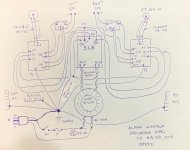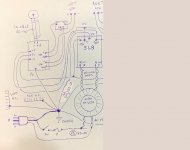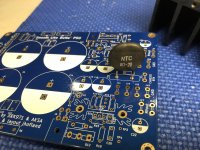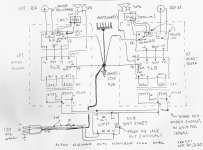Hi Andy,
Those cpu coolers have very narrow fin spacing and the only way they work is for air to be forced through them. Unless the fan is right next to them or if there is air tight duct work, they won’t work right as the spacing is too small to support natural (buoyant convection cooling like traditional passive radiators). Vunce has some good suggestions and has done this many times.
Those cpu coolers have very narrow fin spacing and the only way they work is for air to be forced through them. Unless the fan is right next to them or if there is air tight duct work, they won’t work right as the spacing is too small to support natural (buoyant convection cooling like traditional passive radiators). Vunce has some good suggestions and has done this many times.
Hi Andy,
If you’re using the Dell FD841 cooler this Noctua NF-A9 PWM is a 92mm fan that fits perfectly and moves a heck of a lot more air than the 80mm, believe it or not. It also comes in a slim 14mm wide version that might give you some extra clearance in your chassis.
Noctua NF-A9 PWM, 4-Pin Premium Cooling Fan (92mm, Brown) https://www.amazon.com/dp/B00RUZ059O/ref=cm_sw_r_cp_api_i_dBrOEb1X7E3D0
You do need a PWM fan control board (it can control up to three fans):
1PCS DC 12V PWM PC CPU Fan Temperature Control Speed Controller Board 5*4.3cm | eBay
If you’re using the Dell FD841 cooler this Noctua NF-A9 PWM is a 92mm fan that fits perfectly and moves a heck of a lot more air than the 80mm, believe it or not. It also comes in a slim 14mm wide version that might give you some extra clearance in your chassis.
Noctua NF-A9 PWM, 4-Pin Premium Cooling Fan (92mm, Brown) https://www.amazon.com/dp/B00RUZ059O/ref=cm_sw_r_cp_api_i_dBrOEb1X7E3D0
You do need a PWM fan control board (it can control up to three fans):
1PCS DC 12V PWM PC CPU Fan Temperature Control Speed Controller Board 5*4.3cm | eBay
Thanks for that info about the 14mm deep version, V - with that one, I don't have to change the height of the CPU cooler fin-block, above the floor of the case.
I've found a couple of suppliers here in Oz (all computer shops) - so I am tracking them down.
Andy
I've found a couple of suppliers here in Oz (all computer shops) - so I am tracking them down.
Andy
Could some one shine some light regarding power?
from X's etsy "Recommended use of SLB PSU (sold separately in this shop) with single 600VA 24v trafo (Antek AN-6224 or equivalent) or dual SLB with dual 300VA 24v trafos."
Im looking into a stereo set up and I've been seeing builds with 2x dual SLB and a single or dual trafos. Then I look at the "grounding diac" document it looks to me just a single
dual SLB.
Is there something Im missing a trick or best practices?
Thanks for your help/clarification
from X's etsy "Recommended use of SLB PSU (sold separately in this shop) with single 600VA 24v trafo (Antek AN-6224 or equivalent) or dual SLB with dual 300VA 24v trafos."
Im looking into a stereo set up and I've been seeing builds with 2x dual SLB and a single or dual trafos. Then I look at the "grounding diac" document it looks to me just a single
dual SLB.
Is there something Im missing a trick or best practices?
Thanks for your help/clarification
Perhaps Vunce or Thompsontech have a wiring diagram for their dual trafo dual SLB Aloha Nirvana.
Basically take my sketch and double it but connect one of the amps to the second one rather than sharing an SLB. Keep the power ground of each SLB and amp separate. They only connect via the PE ground through the NTCs.
Basically take my sketch and double it but connect one of the amps to the second one rather than sharing an SLB. Keep the power ground of each SLB and amp separate. They only connect via the PE ground through the NTCs.
Perhaps Vunce or Thompsontech have a wiring diagram for their dual trafo dual SLB Aloha Nirvana.
Basically take my sketch and double it but connect one of the amps to the second one rather than sharing an SLB. Keep the power ground of each SLB and amp separate. They only connect via the PE ground through the NTCs.
I can do that, one thing I wanted to touch base on is that the ground scheme you have posted does not reference NTC from the PE... 😱 It is in the SLB but, not on the no-hum-ground, schematic.
That is, unless I missed something.... Again. 😛
About forced cooling: Can it be considered as "ideal" that the air expelled by the CPU radiator fan comes directly from the amplifier box? I mean if it can be ordered, it would be better to place the CPU radiator at the back of the box and make a hole in it, thus allowing all the hot air inside to come out quickly. Logically the top (lid) and bottom (base), would be chosen with multiple ventilation slots.
Regards
Regards
Hi Karucho,
The thermal issues of Class Amps are very problematic.
Since air rises, it is best to have the air rising off the heatsink vertically through a vent in the center of the case.
This spreads the heat above the case, rather than behind or to the side, where it could damage soft furnishes. Of course, if the heat rises from the central point of the enclosure it would not be a good idea to put the amp into an enclosed cabinet, but in such cases hot air expelled front, side, or rear would not be good either. Correspondingly, the input of the fan must have sufficient space beneath the amp case to draw cool air from beneath it.
My approach is to expel the hot air vertically, from the center of the enclosure. The enclosure should be placed either on the floor, or on a table, with NOTHING ABOVE THE AIR VENT. Care is needed to present thoughtless people putting books on the top of the enclosure, of course, so some care with operation is necessary to avoid thermal damage to the output stage.
HD
The thermal issues of Class Amps are very problematic.
Since air rises, it is best to have the air rising off the heatsink vertically through a vent in the center of the case.
This spreads the heat above the case, rather than behind or to the side, where it could damage soft furnishes. Of course, if the heat rises from the central point of the enclosure it would not be a good idea to put the amp into an enclosed cabinet, but in such cases hot air expelled front, side, or rear would not be good either. Correspondingly, the input of the fan must have sufficient space beneath the amp case to draw cool air from beneath it.
My approach is to expel the hot air vertically, from the center of the enclosure. The enclosure should be placed either on the floor, or on a table, with NOTHING ABOVE THE AIR VENT. Care is needed to present thoughtless people putting books on the top of the enclosure, of course, so some care with operation is necessary to avoid thermal damage to the output stage.
HD
Hi Karucho,
The thermal issues of Class Amps are very problematic.
Since air rises, it is best to have the air rising off the heatsink vertically through a vent in the center of the case.
This spreads the heat above the case, rather than behind or to the side, where it could damage soft furnishes. Of course, if the heat rises from the central point of the enclosure it would not be a good idea to put the amp into an enclosed cabinet, but in such cases hot air expelled front, side, or rear would not be good either. Correspondingly, the input of the fan must have sufficient space beneath the amp case to draw cool air from beneath it.
My approach is to expel the hot air vertically, from the center of the enclosure. The enclosure should be placed either on the floor, or on a table, with NOTHING ABOVE THE AIR VENT. Care is needed to present thoughtless people putting books on the top of the enclosure, of course, so some care with operation is necessary to avoid thermal damage to the output stage.
HD
Thanks AKSA for your response. I think I understand your idea.
So NH-D9L dual tower CPU cooler, should blow the air up, through a hole made in the top cover .... right?
I think, if I am not mistaken, that I should anchor The NH-D9L on one side of the box and that the fan remains in a horizontal position, drawing air from the bottom to the lid, this being correctly drilled ...
Thanks Aksa for making me understand your idea.
Regards
Thanks Aksa for making me understand your idea.
Regards
Could some one shine some light regarding power?
from X's etsy "Recommended use of SLB PSU (sold separately in this shop) with single 600VA 24v trafo (Antek AN-6224 or equivalent) or dual SLB with dual 300VA 24v trafos."
Im looking into a stereo set up and I've been seeing builds with 2x dual SLB and a single or dual trafos. Then I look at the "grounding diac" document it looks to me just a single
dual SLB.
Is there something Im missing a trick or best practices?
Thanks for your help/clarification
If you are doing dual SLB, I would do dual Trans too. It's simple really, You just duplicate the ground schematic for each side. So one trans and one SLB for each. THe grounding scheme doesn't show the ground loop break though. It is on the SLB schematic, but omitted from the drawing, so I added it in to the attached.
The second schematic is showing half or the left side, you simply build one just like it for the right and include the other trans and SLB. Make sure you do the inrush for each side and the ground loop breaker too. The grounding point will be the same point and will go from bottom to top SLB1-2 (PE) through NTC 8D-20, on bottom, Amp1(PE) and Amp 2 (PE)
I think I have that right X?
Attachments
Last edited:
JT,
The GLB is in the schematics AND included on the SLB/Alpha Nirvana pcbs. It’s the NTC that installs right next to the GND faston tabs.
You edited in a duplicate NTC, it’s not needed because it’s already installed.
The GLB is in the schematics AND included on the SLB/Alpha Nirvana pcbs. It’s the NTC that installs right next to the GND faston tabs.
You edited in a duplicate NTC, it’s not needed because it’s already installed.
'JT,
The GLB is in the schematics AND included on the SLB/Alpha Nirvana pcbs. It’s the NTC that installs right next to the GND faston tabs.
You edited in a duplicate NTC, it’s not needed because it’s already installed.
I'm understand there are GLB on the Amps, but I also have one on each SLBs PE to ground. as shown in the SLB schematic.
Attachments
It’s already there.
The above grounding scheme drawing is specific to an AN/SLB layout. Adding the NTC to this drawing will further confuse.
If using a different power supply, it is a good safeguard to add this on your own.
The above grounding scheme drawing is specific to an AN/SLB layout. Adding the NTC to this drawing will further confuse.
If using a different power supply, it is a good safeguard to add this on your own.
Attachments
Last edited:
It’s already there.
I had to go open one up... yup, I just remember there was one there, but didn't remember it was on the board.
I still might be useful to show one on the ground scheme as everyone that builds an AN will not always be using an SLB.
Thanks for the clarity.
JT
Last edited:
- Home
- Amplifiers
- Solid State
- Alpha Nirvana 39w 8ohm Class A Amp




